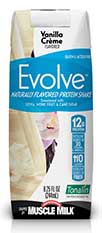Tipping the Scales Toward Better Health
NUTRACEUTICALS
 Diets trends come and go as people continue to work to lose weight and maintain ideal weight throughout their lives. Buzzwords in weight management today include satiety, lean protein, low carb, and fat burning. Here are some of the ingredients that address these areas.
Diets trends come and go as people continue to work to lose weight and maintain ideal weight throughout their lives. Buzzwords in weight management today include satiety, lean protein, low carb, and fat burning. Here are some of the ingredients that address these areas.
Satiety
• Dairy protein. “Diets high in protein, and specifically dairy protein, have a satiating effect,” said Carrie Schroeder, Key Account Manager, Nutrition, Fonterra North America, Rosemont, Ill. (www.fonterra.com). “Eating higher levels of protein and lower levels of carbs helps you feel full, and you find yourself snacking less,” she explained. “In a pilot study that Fonterra conducted, females who supplemented their diet with 20 g of additional protein at both breakfast and lunch over a three-week period lost 2 inches from their waist. Muscle is an active tissue, and as you feed your body with protein, and your muscles continue to develop, you are contributing to keeping your metabolism active and ultimately managing weight.” Fonterra offers whey protein concentrates and isolates, as well as other dairy ingredients.
Bendtsen et al. (2013) examined whether casein, whey, and other protein sources exert different metabolic effects and targets to clarify the underlying mechanisms (beyond their metabolic effects). Casein and whey differ in absorption and digestion rates, with casein being a “slow” protein and whey being a “fast” protein. In addition, they differ in amino acid composition. Data indicated that whey is more satiating in the short term, whereas casein is more satiating in the long term, and that amino acid composition, rate of absorption, and protein/food texture may be important factors for protein-stimulated metabolic effects.
• Rice protein. Joy et al. (2013) indicated that both whey and rice protein isolate administration post resistance exercise improved indices of body composition and exercise performance; however, there were no differences between the two groups. The researchers were looking to determine if the post-exercise consumption of rice protein isolate could increase recovery and elicit adequate changes in body composition compared to equally dosed whey protein isolate if given in large, isocaloric doses.
Oryzatein™ rice protein from Axiom Foods, Los Angeles, Calif. (www.axiomfoods.com), was used in the study. It is enzymatically extracted from multiple layers of the whole grain, is not hydrolyzed, and does not contain monosodium glutamate.
• Dietary fiber. A study presented at the 2013 American Society for Nutrition Experimental Biology conference demonstrated fiber’s ability to maintain satiety after a meal (Tate & Lyle, 2013). Using a double-blind, randomized cross-over design, researchers from Iowa State University found that an emerging fiber, soluble fiber dextrin, may help promote satiety from 3 to 8.5 hours after consumption. Tate & Lyle’s soluble fiber dextrin is a resistant dextrin that can be isolated from tapioca or corn.
Clinical research has documented a positive effect on total daily energy intake when Litesse® Ultra™ polydextrose from DuPont Nutrition & Health, Terre Haute, Ind. (www.dupont.com), is consumed in a mid-morning snack (DuPont, 2013). Subjects consumed chocolate milk drinks with an equal energy load and varying doses of polydextrose (from 0 g to 25 g) 90 minutes prior to being served an unlimited pasta-based test meal. Total meal energy intake was significantly lower when the subjects had received 6.3 g, 12.5 g, or 25 g of Litesse Ultra in the pre-meal snack, compared to the no-polydextrose control. Consumption of 25 g of polydextrose led to the lowest meal energy intake, indicating that the impact on satiety is dose-dependent.
• Raisins. Patel et al. (2013) showed that ad libitum consumption of raisins has potential as an after-school snack to achieve low snack intake prior to dinner compared to consumption of potato chips and cookies in children 8–11 years old. On four separate weekdays one week apart, children were given a standardized breakfast, morning snack (apple), and a standardized lunch. After school, children randomly received 1 of 4 ad libitum snacks and were instructed to eat until “comfortably full.” Appetite was measured before and 15, 30, and 45 minutes after snack consumption. Children consumed the least amount of calories from raisins and grapes and the most from cookies; however, the weight of raisins consumed was similar to potato chips (about 75 g) and lower compared to grapes and cookies. Consuming raisins and grapes led to lower cumulative food intake (breakfast + morning snack + lunch + after-school snack), while consuming cookies increased cumulative food intake compared to the other snacks.
• Almonds. Tan and Mattes (2013) provided evidence that daily consumption of 1.5 ounces of almonds as a snack or with a meal suppressed hunger and helped study subjects meet the recommended dietary intake of vitamin E without affecting body weight. This was a 4-week randomized, parallel-arm study that entailed consuming almonds (43 g/day) with breakfast or lunch or alone as a morning or afternoon snack, or consuming no almonds. Consuming almonds as a snack reduced hunger and the desire to eat during the acute-feeding session. Without specific guidance, daily energy intake was reduced to compensate for energy from the provided almonds.
--- PAGE BREAK ---
• Korean pine nut. Derived from a specific Korean pine nut, PinnoThin® from Stepan Lipid Nutrition, Maywood, N.J. (www.stepan.com, www.pinnothin.com), has been shown in clinical studies to promote satiety. In a randomized doubleblind, cross-over trial, researchers showed that within 30–60 minutes after taking 3 g of PinnoThin in the form of oil or its natural metabolites, the release of the satiety hormone cholecystokinin (CCK) was significantly increased in the blood of the test subjects. The natural metabolites of PinnoThin also significantly increased the release of another satiety hormone, glucagon-like peptide 1, in the blood. Prospective food intake was also reduced after administration of the natural metabolites of PinnoThin. In a separate study, participants given these also showed a significant effect on food intake (9% reduction) and a 7% reduction in caloric intake.
• Potato protein extract. An all-natural potato protein extract, Slendesta®, from Kemin, Des Moines, Iowa (www.kemin.com), has been shown to help people feel full sooner and longer. The active component in Slendesta is a natural protein called proteinase inhibitor II that is found just under the skin of the potato. It works by enhancing the body’s natural release of CCK. In 2012, Kemin announced that Fullbar LLC (www.fullbar.com), a brand of weight management products, would feature Slendesta in its reformulated products of bars, ready-to-drink shakes, chewable gummies, gum, and supplement capsules.
• Saffron. Gout et al. (2010) indicated that consumption of Satiereal® from PL Thomas, Morristown, N.J. (www.plthomas.com), produced a reduction of snacking and created a satiating effect that could contribute to body weight loss in a study of 60 mildly overweight female subjects. The mean snacking frequency was also significantly decreased. The ingredient’s clinically proven formula improves the levels of the neurotransmitter serotonin. Serotonin increases the satiety state while decreasing appetite. Satiereal is derived from the flowers of saffron crocus.
 Fat Reduction
Fat Reduction
• Conjugated linoleic acid. Weight management products often contain conjugated linoleic acid (CLA) thanks to its ability to reduce body fat mass and improve body composition. Tonalin® CLA from BASF Nutrition & Health, Florham Park, N.J. (www.basf.com, www.tonalin.com), is featured in a product introduced earlier this year, Evolve™ protein shake from CytoSport Inc., the maker of Muscle Milk®. Tonalin boasts 18 major studies proving its safety and effectiveness. It is derived from natural safflower oil using a proprietary process. Clinical studies have shown that Tonalin CLA reduces body fat by decreasing the amount of fat the body stores after eating, increasing the rate of fat breakdown, increasing the rate of fat metabolism, and decreasing the total number of fat cells.
Stepan Lipid Nutrition also offers a CLA ingredient, Clarinol® CLA. Studies show that daily consumption of 3 g of CLA combined with a balanced diet and exercise program can reduce body fat in 8–12 weeks. Clarinol CLA is found in a wide variety of weight management products, including protein shakes and ready-to-drink shake mixes.
• Coffee bean extract. Developed from decaffeinated green coffee bean extract, Svetol® from Naturex Inc., South Hackensack, N.J. (www.naturex.com), is clinically proven to inhibit glucose-6-phosphatase and increase the rate of fat release from the adipose tissue. The ingredient is produced using a proprietary extraction process, which ensures a specific profile of active molecules in particular chlorogenic acids. These compounds reduce intestinal glucose absorption. A recent clinical study, which followed 50 people, ages 19–75 over a period of 60 days, found that those who took 400 mg of Svetol per day lost an average of nearly 6% of body weight and increased their lean mass (Naturex, 2013).
• Canola oil. Research presented at the American Heart Association’s Epidemiology and Prevention/Nutrition, Physical Activity, and Metabolism 2013 Scientific Sessions showed that canola and high-oleic canola oils can lower abdominal fat when used in place of other selected oil blends in a heart-healthy diet for weight maintenance (CanolaInfo, 2013). In the multi-center, randomized, controlled trial, 121 subjects at risk for metabolic syndrome were given a weight-maintenance, heart-healthy diet with a daily smoothie containing one of five oils. The results showed that those who consumed canola or high-oleic canola oils on a daily basis for four weeks lowered their belly fat by 1.6%. Abdominal fat was unchanged by the other three oils, which included a flax/safflower oil blend, corn/safflower oil blend, and high-oleic canola oil enriched with an algal source of the omega-3 DHA. Both the flax/safflower and corn/safflower oil blends were low in monounsaturated fat.
“Monounsaturated fat appears to be responsible for these benefits,” said Penny Kris-Etherton, Professor of Nutrition, Pennsylvania State University, and one of the lead researchers. “Reducing abdominal fat is one way that dietary MUFA may decrease metabolic syndrome risk factors.”
Metabolism
• Polyphenols. Nieman et al. (2013) demonstrated that consuming polyphenols from blueberries or green tea led to a prolonged “afterburn” effect after people exercised and often while they slept, regardless of the ensuing levels of activity (NCSU, 2013).
The subjects were long-distance runners who were given either a soy protein complex infused with polyphenols from blueberries and green tea or a plain soy protein complex. They took the samples for two weeks, and during 3 days of running for 2.5 hours each day. “Following prolonged running, athletes experience transient inflammation, oxidative stress, and immune dysfunction,” explained David Nieman, Director of the Appalachian State University Human Performance Lab and lead author on the study. “Metabolomics, a new technology, showed that the intense exercise increased gut permeability, promoting the transfer of phenolics into the body in much higher amounts then before the exercise.” An equally significant finding was that the subjects in the treatment group demonstrated a longer spike in their metabolism after exercise, known as metabolic afterburn.
 Linda Milo Ohr,
Linda Milo Ohr,
Contributing Editor, Denver, Colo.
[email protected]
References
Bendtsen, L.Q., Lorenzen, J.K., Bendsen, N.T., Rasmussen, C., and Astrup, A. 2013. Effect of dairy proteins on appetite, energy expenditure, body weight, and composition: a review of the evidence from controlled clinical trials. Adv. Nutr. 2013. 4:418-438.
CanolaInfo. 2013. Canola and High-Oleic Canola Oils Reduce Belly Fat in Adults. Canolainfo.org, press release, March 22.
DuPont. 2013. New study links polydextrose with reduced daily energy intake. DuPont Nutrition & Health, press release, June 6.
Gout, B., Bourges, C., and Paineau-Dubreuil, S. 2010. Satiereal, a Crocus sativus L extract, reduces snacking and increases satiety in a randomized placebo-controlled study of mildly overweight, healthy women. Nutr. Res. 30: 305-313.
Joy, J.M., Lowery, R.P., Wilson, J.M., Purpura, M., De Souza, E.O., Wilson, S.M.C., Kalman, D.S., Dudeck, J.E., and Jäger, R. 2013.The effects of 8 weeks of whey or rice protein supplementation on body composition and exercise performance.Nutr. J. 12: 86.
Naturex. 2013. Svetol® by Naturex effective for weight loss and body toning. Naturex Inc., press release, Jan. 23.
Nieman, D.C., Gillitt, N.D., Knab, A.M., Shanely, R.A., Pappan, K.L., Jin, F., and Lila, M.A. 2013. Influence of a polyphenol-enriched protein powder on exercise-induced inflammation and oxidative stress in athletes: a randomized trial using a metabolomics approach. PLOS ONE 8(8): e72215, doi:10.1371/journal.pone.0072215.
NCSU. 2013. Blueberries, green tea help athletes burn fat while sleeping. North Carolina State University, press release, Aug. 30.
Patel, B.P., Bellissimo, N., Luhovyy, B., Bennett, L.J., Hurton, E., Painter, J.E., and Anderson, G.H. 2013. An after-school snack of raisins lowers cumulative food intake in young children. J. Food Sci. 78(s1): A5-A10, doi: 10.1111/1750-3841.12070
Tan, S.Y., and Mattes, R.D. 2013. Appetitive, dietary and health effects of almonds consumed with meals or as snacks: a randomized, controlled trial. Eur. J. Clin.Nutr.doi:10.1038/ejcn.2013.184
Tate & Lyle. 2013. Three new studies reveal added fibres impact on various health indices. Tate & Lyle, press release, April 22.


